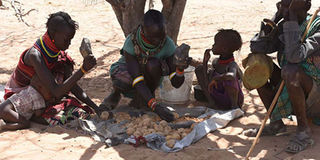Hungry children a human, economic crisis

A family in Lorukia village, Turkana County, feeds on wild fruits on March 23, 2019 as hunger bites. No child should go hungry. PHOTO | FILE | NATION MEDIA GROUP
What you need to know:
- Climate change and conflict also have a significant impact. Three-quarters of all stunted children under the age of five live in conflict zones.
- The lasting effects of hunger on the cognitive and physical development of the African child and their families has led to the stunted development of societies.
Hunger is the single most acute problem Africa’s children face.
Around 60 million children across Africa are hungry. Not the mildly uncomfortable sort of hunger that comes from skipping the odd meal, but permanent, relentless malnourishment, stunting and wasting.
No child should go hungry. I find it utterly unacceptable that lack of decent food is still killing African children on such a vast scale in the 21st Century.
In some parts of Africa, in 2014-2017, an additional 44 million were affected by hunger.
Hunger is a factor in nearly half of all child deaths in Africa. Nine out of 10 African children do not eat the minimum amount of food with the desired frequency.
One in three is stunted. Two out of five don’t get regular meals. A third of child deaths can be traced to micronutrient deficiencies.
POVERTY
Political leaders and child rights experts converge in Addis Ababa, Ethiopia, today and tomorrow to find a way out of Africa’s child hunger problems.
The Eighth International Policy Conference on the African Child will discuss how to address child hunger and develop and implement policies and programmes.
Child hunger is driven by poverty and wealth and gender inequality.
Children from poor and rural backgrounds suffer the most from hunger, and women and girls are disproportionately affected.
In some countries, stunting rates are twice as high among rural children as among urban ones.
The continent’s food system is broken. Increased food production has not resulted in better diets for children.
Supply chains can’t serve rapidly expanding urban populations and the rural poor.
CONFLICT
Agricultural production, driven by economic targets, encourages production of major cereal crops instead of more nutritious foods such as pulses, fruit and vegetables.
Half of the African countries that committed to a 10-year African Regional Nutrition Strategy in 2015 are off course to meet their targets. Eight are off course to meet childhood wasting targets and only two might meet the stunting targets.
Climate change and conflict also have a significant impact. Three-quarters of all stunted children under the age of five live in conflict zones.
In 2017, armed conflict was the biggest single cause of acute food insecurity in 18 countries, leading to 74 million people needing urgent aid.
Tropical storms, droughts and flooding caused food insecurity for over 21 million people in Ethiopia, Malawi, Zimbabwe and Kenya.
PRODUCTIVITY
Child hunger is fundamentally political — the offspring of an unholy alliance of political indifference, unaccountable governance and economic mismanagement.
It’s a silent tragedy, largely unacknowledged but tolerated, perhaps because it is a poor person’s problem.
Hunger has devastating consequences. Hungry children perform less well in school and suffer from low esteem. They are less healthy and productive, earning less as adults than their peers.
The human and social impact of hunger is clear, but less well-known are the huge economic costs. Hunger costs African countries as much as 17 per cent of their GDP and threatens their future development.
The lasting effects of hunger on the cognitive and physical development of the African child and their families has led to the stunted development of societies.
Ensuring that children have enough good food is the best investment Africa can make to build its human capital and economic future.
Mrs Machel is a women’s and child rights’ campaigner.




